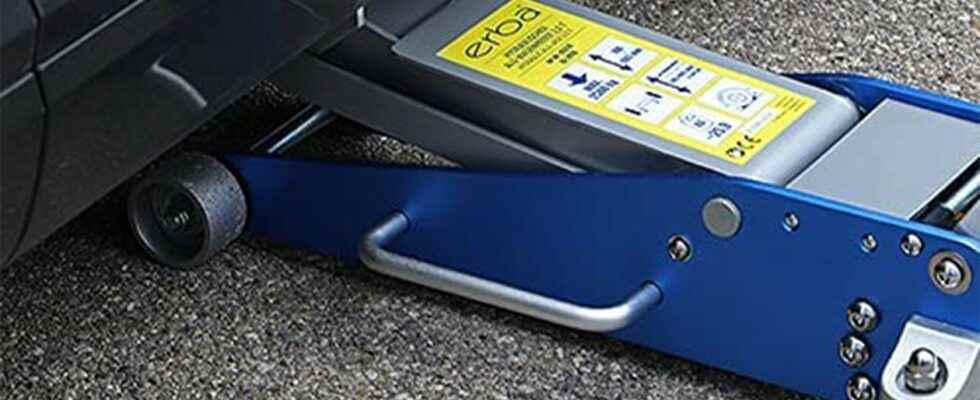Whether changing tires or small repairs on the car – a trolley jack is almost indispensable for do-it-yourselfers. The motor vehicle monitoring organization KÜS tested nine of them – and found huge differences.
Those made of aluminum are up to 20 kilograms lighter than the 2.5-ton jack made of steel, which weighs up to 40 kilograms. The test winner and at the same time price-performance winner with the highest number of points and the grade “good” is one of the heavier examples of the Erba 03276 maneuvering jack (165 euros). It is characterized by an easily adjustable hydraulic system and can be moved with little resistance. Its safety valve triggers precisely at the maximum load of 2.5 tons. After the test, no damage was found on the jack. Leaking even in the packaging The five jacks listed below with the result “satisfactory” differ significantly in quality, price and performance. The Stier hydraulic trolley jack (200 euros) mastered the stress test very well without oil loss on the cylinder and deformation of the chassis. However, the processing (traces of oil in the box) and the moderate rolling properties leave a lot to be desired. At 447 euros, the Kunzer WK 1019 Alu is by far the most expensive jack in the test. With a weight of only 19.2 kilograms, it is the lightest of the large professional jacks and scores with the lowest minimum lifting height. The safety valve triggers precisely. However, slight deformation of the chassis after the stress test leads to a significant point deduction. The BGS technic 2889 (225 euros) shows traces of black hydraulic oil on the cylinder after the stress test, but the hydraulics still work perfectly. The safety valve of the Güde GRH 2.5/460 AL (186 euros) triggers far too early and therefore does not achieve the promised lifting capacity of 2.5 tons. The very inexpensive Enva Car Jack (56 euros) with a low minimum lifting height of 85 millimeters Like the Kunzer jack, it is particularly suitable for vehicles with low ground clearance. The safety valve of the Enva jack opens late, but it survives the stress test unscathed. From here it gets dangerous. The two trolley jacks Unitec (48 euros) and Omega Mechanix 2602701 (255 euros) are only “sufficient” in terms of performance and quality. With a weight of At only 9.2 kilos, the compact Unitec is the lightest and also the cheapest jack in the test. However, it can be dangerous in practice, because its safety valve does not trigger even with a load of 3 tons. The Omega jack is the second heaviest at almost 26 kilos, but also lifts 2.7 tons. Its major drawback: the safety valve opens too late, the hydraulics can only be dosed very imprecisely and the chassis deforms during the load test. Last but not least and by far the worst jack in the test is the KS-Tools 161-0365, which the experts rated as “poor”. SlimPower (159 euros). The safety valve only triggers very late and the aluminum chassis does not withstand the stress test. It deforms so much that the lift arm no longer slides back into the rest position. This jack is therefore absolutely unsuitable for practical use on the vehicle. This is how KÜS tested Heavy equipment was required for the test of the trolley jack: Among other things, a hydraulic press weighing around 100 kilograms, which applies a pressing force of up to 20 tons. All jacks were purchased online. The operating instructions, the equipment features, the workmanship, the weight and the dimensions were checked. In addition to the maximum lifting height, the minimum lifting height is also important in order to be able to lift low-lying cars. The most important part of the tests is the load test: Can the jacks withstand the target load without breaking or deforming damage? The target load results from 1.5 times the release weight of the safety valve and is therefore dependent on how precisely the safety valves work. They should respond as precisely as possible when the highest permissible maximum load has been reached. In concrete terms: the moment a jack reaches its maximum load of 2,000 kilos, for example, the safety valve should open and prevent further lifting in order to protect the jack’s hydraulics and chassis from overloading. The forces were determined using a compression force gauge clamped between the hydraulic press and the lifting arm. Dangerous: In four out of nine jacks, the safety valve triggers too late or not at all.
source site-13
